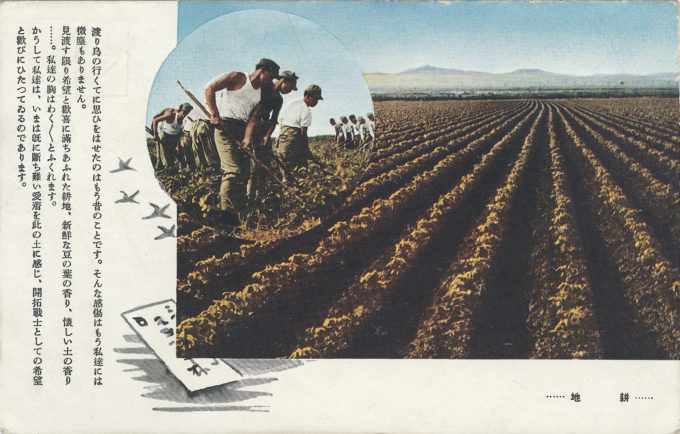
Patriotic Youth Brigade farmers propaganda postcard, Manchukuo, c. 1940. The left-hand caption appears to be lyrics to a (untitled) patriotic song:
It is a long time ago that we used to think about the paths of migratory birds.
We no longer have a trace of such sentimentality.
As far as the eye can see, the land is filled with hope and joy,
the smell of fresh bean leaves, and the scent of fresh soil.
Our hearts are filled with excitement.
Our hearts are filled with excitement.
Our hearts are filled with excitement.
We now feel an unshakable attachment to this soil
and are filled with the hope and joy of pioneering warriors.
See also:
South Manchuria Railway Co., c. 1930-1940.
Miscellaneous scenes of Manchukuo, c. 1940.
Tsitsihar (Qiqihar), Manchuria, c. 1940.
“Over time, however, as the labour crisis deepened and the rural economy in Japan improved it became increasingly difficult for local leaders to meet the assigned quotas. To sustain the movement the Kwantung Army, the Ministry of Colonial Affairs, and other colonial agencies redirected the system to tap into a ready reserve of prospective emigrants, boys aged 16 to 19.
“Forming the Youth Brigades was the last major emigration initiative, and again, emerged first as a Kwantung Army plan and then progressed through the domestic political system. While the groups came into existence to make up for shortfalls in adult emigration, the program was infused with a spiritual veneer that joined elements of Katô Kanji’s Shinto-tinged ideology with the minzoku kyôwa (racial harmony) mission, training the Brigades as the central element of the settlement movement. Like the previous groups of emigrants the Youth Brigades were intended to function as guards along the border and transport lines, thereby acting to ‘safeguard peace in the Orient.’
“In the initial burst of excitement, and amid a media blitz of positive publicity and strong official encouragement, applications for slots in the brigades nearly doubled the target figure set by campaign organizers.
“Candidates were sent to Ibaragi prefecture for two months of training at the main Youth Brigade Training Centre, after which they crossed to Manchuria for three years of on-site training at camps scattered throughout north Manchuria, and then moved on to Youth Brigade agricultural settlements.”
– “Japan in Manchuria: Agricultural Emigration in the Japanese Empire, 1932-1945”, by Kevin McDowell, Eras Journal, November 2003

